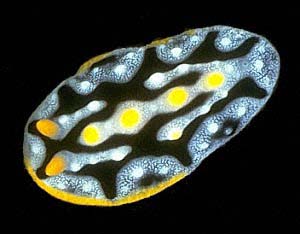
Phyllidia exquisita
Brunckhorst, 1993
Order: NUDIBRANCHIA
Suborder: DORIDINA
Family: Phyllidiidae
DISTRIBUTION
Known from the central and western Pacific Ocean and the north-eastern Indian Ocean (Thailand).
PHOTO
3 m depth, Lion Island, Papua New Guinea, 18 Apr. 1984, dorsal view of 11 mm specimen, Photo: C. Carlson & P. Hoff (Brunckhorst, 1993: Plate 3C).
Notes compiled from Brunckhorst, 1993:
Phyllidia exquisita is a relatively small species characterised by the possession of white background colour with black lines, two median longitudinal areas of white on either side of the central tubercles, small, simple rounded tubercles which occur in definite rows (but do not form ridges), yellow edge to the mantle margin, and white coloration ventrally.
The present species does not possess the orange-yellow background coloration or the pattern found in Phyllidia ocellata. It is most similar to Phyllidia willani and Phyllidia babai in the possession of a white background colour and black markings. Both those species are much larger. Phyllidia willani also differs from P. exquisita in having black swirls, large and small tubercles, a characteristic granular appearance to the notum, and grey coloration ventrally. Phyllidia babai has black rings (rather than lines) and larger tubercles.
Reference:
• Brunckhorst, D.J. (1993) The systematics and phylogeny of Phyllidiid Nudibranchs (Doridoidea). Records of the Australian Museum, Supplement 16: 1-107.
Rudman, W.B., 1999 (January 12) Phyllidia exquisita Brunckhorst, 1993. [In] Sea Slug Forum. Australian Museum, Sydney. Available from http://www.seaslugforum.net/find/phylexqu
Related messages
Phyllidia exquisita? from Sabah, Malaysia
November 25, 2009
From: Mirjam Broos
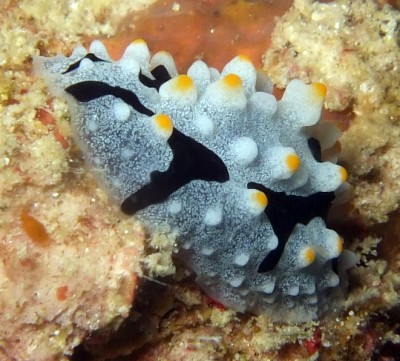
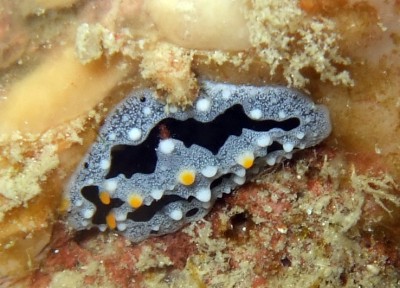
Hello Bill,
I have a hard time trying to distinguish the nudies belonging to Phyllidiidae family. Is this Phyllidia exquisita?
Locality: Siamil island, East Fort, Sabah, Malaysia, 22 september 2009. Photographer: Geert Prast.
Thanks again,
Mirjam
mirjam.broos@planet.nl
Broos, M., 2009 (Nov 25) Phyllidia exquisita? from Sabah, Malaysia. [Message in] Sea Slug Forum. Australian Museum, Sydney. Available from http://www.seaslugforum.net/find/22806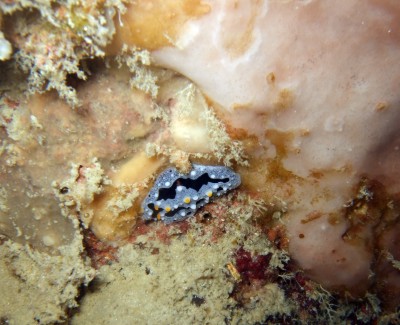
Dear Mirjam,
I think we all have problems with this family. There are a number of species with these opaque white granular specks scattered all over the mantle including P. exquisita, P. ocellata, P. willani and P. babai. Your animal doesn't fit any of them very well, so P. exquisita could well be correct. At times I think they are all just colour forms of P. ocellata.
Best wishes,
Bill Rudman
Phyllidia exquisita? Hawaii
October 2, 2008
From: Jerry Kane
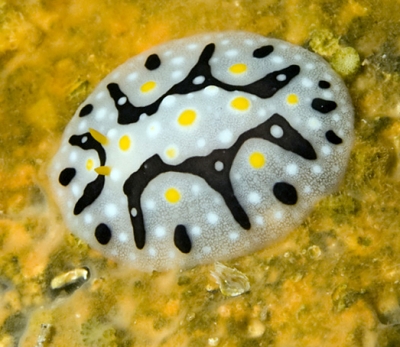
Concerning message #21800:
Hello
I saw the recent discussion on Phyllidia sp. from North Sulawesi and wanted to share a photo of a slug I saw recently in Hawaii. Although not identical to Marli's slug, it seems similar to my uneducated eye. Any comments on this one would be appreciated.
Locality: Kona, 80 ft, Hawaii, US, Central Pacific, 21 September 2008, cave wall. Length: 1 inch. Photographer: Jerry Kane.
Thanks,
Jerry
kane@hawaiiantel.net
Kane, J., 2008 (Oct 2) Phyllidia exquisita? Hawaii. [Message in] Sea Slug Forum. Australian Museum, Sydney. Available from http://www.seaslugforum.net/find/21919Dear Jerry,
Thanks for this photo. I agree with your thoughts that this is closest to Phyllidia exquisita. It doesn't have any yellow or ornage around the mantle border, but that seems to be optional. It also has similarities to P. willani. As I have discussed quite often on the Forum, I suspect a number of these species are just white forms of the very variable P. ocellata . Thanks for your photo. I can't give a definite answer, but your photo might turn out to be the piece that solves the P. exquisita-P. ocellata puzzle.
Best wishes,
Bill Rudman
Phyllidia sp. from North Sulawesi
August 20, 2008
From: Marli Wakeling
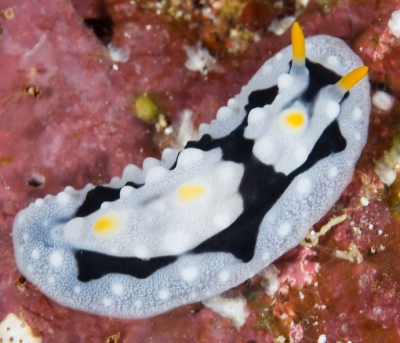
Hi Bill,
A puzzle from Bunaken Marine Park. It doesn't fit Phyllidia babai or P. willani, and the distinctive pattern is interesting. Any ideas?
Locality: Bunaken Marine Park, 40 feet, Sulawesi, Indonesia, Indo-Pacific, 22 July 2008, Wall. Length: 25mm. Photographer: Marli Wakeling.
Cheers,
Marli Wakeling
scubamarli@gmail.com
Wakeling, M., 2008 (Aug 20) Phyllidia sp. from North Sulawesi. [Message in] Sea Slug Forum. Australian Museum, Sydney. Available from http://www.seaslugforum.net/find/21800Dear Marli,
As you know I have great reservations about P. willani, P. babai and P. exquisita and their relationship to the very variable P. ocellata, and Yasuhiro Shirai's photo of P. ocellata and 'P. babai' mating [message #5458] strongly support my doubts.
My feeling is that this will turn out to be P. ocellata, but discarding unnecessary species is unfortunately much more difficult than erecting new ones, so to preserve the status quo my feeling is that we should identify your animal as P. exquisita on the basis of the row of yellow tubercles in the dorsal midline and the arrangement of the black pattern. It doesn't have a broken yellow band at the mantle edge as is usual in P. exquisita, but P. babai sometimes has one and sometimes doesn't, so I think we can consider it to be a variable character. [see also message #21802 ].
Best wishes,
Bill Rudman
Phyllidia exquisita from Lembeh Strait
May 28, 2007
From: Mike Krampf
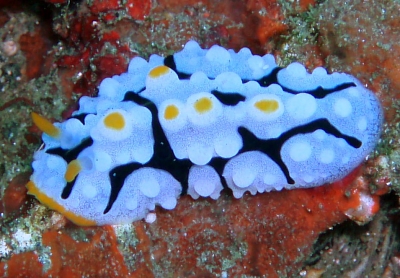
This Phyllidia sp has an interesting coloration that I haven't been able to match in a book. Can you help in identifying this one?
Locality: Lembeh Strait, 55 ft, Indonesia, Celebes Sea, 27 October 2006, Fringing reef. Length: 3 cm. Photographer: Mike Krampf.
Thanks,
Mike
mtkrampf@yahoo.com
Krampf, M., 2007 (May 28) Phyllidia exquisita from Lembeh Strait. [Message in] Sea Slug Forum. Australian Museum, Sydney. Available from http://www.seaslugforum.net/find/18878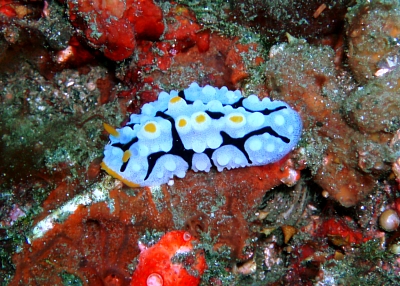
Dear Mike,
This is Phyllidia exquisita. One character of this species is that the orange margin to the mantle is only present around the anterior end. It is interesting to find it associated with an orange sponge. Many phyllidiids are found on orange sponges so its possible that many of them will turn out to be related - but we still have to a lot to do before we can identify the sponges satisfactorily.
Best wishes,
Bill Rudman
Phyllidia exquisita from West Papua
May 24, 2007
From: Jim Anderson
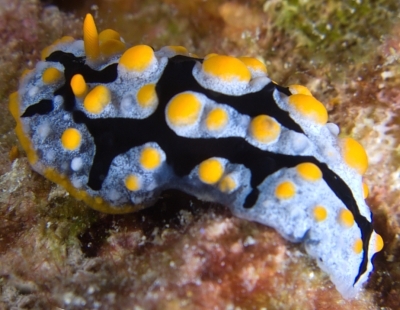
Dear Bill,
Could this animal be Fryeria rueppelii? The yellow edge to the mantle does not appear to extend all the way round nor be as pronounced as other examples on the Forum. The images were taken by me during a recent trip to Raja Ampat in West Papua, Indonesia and some details follow
12 March 07; depth, 15 metres; site East Fam Wall, Penemu Island; coral reef slope ; length 35 mm
Kind regards,
Jim Anderson
Scottish Nudibranchs
jander4454@gmail.com
Anderson, J., 2007 (May 24) Phyllidia exquisita from West Papua. [Message in] Sea Slug Forum. Australian Museum, Sydney. Available from http://www.seaslugforum.net/find/19933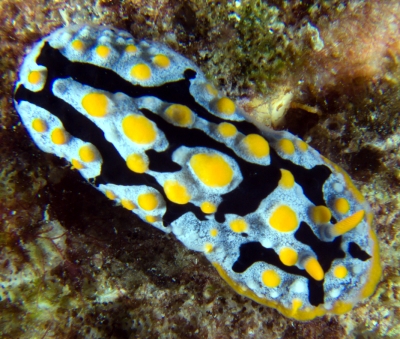
Dear Jim,
My first thoughts were F. rueppelii but the orange border only around the anterior end is a character of Phyllidia exqusita, as are the small whitish granular glands all over the mantle.
Best wishes,
Bill Rudman
Re: Phyllidia exquisita? from Ningaloo
December 14, 2006
From: Kristin Anderson
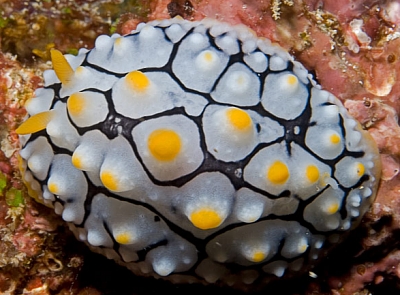
Concerning message #15656:
When I first saw this nudibranch (upper & middle photos) I thought it was a Phyllidia exquisita but with the orange going all the way around the mantle, I wasn't 100% sure. It also looks quite different to the third image [lower photo] that I have as a Phyllidia exquisita. Certainly could be variations, we get a lot of them!
Locality: Ningaloo Reef, 12m, Western Australia, Indian Ocean, 23 October 2006, limestone & hard coral reef. Length: 3 cm. Photographer: Kristin Anderson.
Appreciate your feedback.
Kristin Anderson
kristin@OceansByAnderson.com
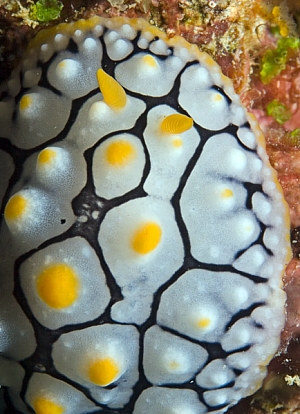

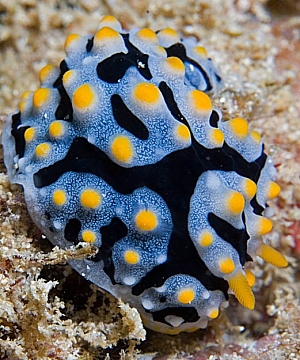
Dear Kristin,
Have a look at Clay Bryce's message [#838 ] from NW Australia. I think we still have much to learn about the identity of many of the phyllidiid species. Brunckhorst's great revision should be treated as a beginning rather than an end. Certainly there are many photos sent to the Forum which are puzzling. One useful contribution you could make would be to find out what these animals look like from the underside. If they are relatively common, it could be useful to systematically photograph a few from above and below and see if any consistent differences show up. For example some species, like P. elegans, have a black median line on the sole of the foot, and some have the foot bordered in yellow and others don't. I don't know if you will find any differences but it might give us a clue to where we should be paying more attention.
I have included a close-up [middle right] showing the anal papillae. One possibility was that your animal was a form of Fryeria rueppelii, but in that genus the anus opens posteriorly beneath the mantle skirt.
Best wishes,
Bill Rudman
Phyllidia coelestis? from Borneo
August 8, 2006
From: Asther M. Lau
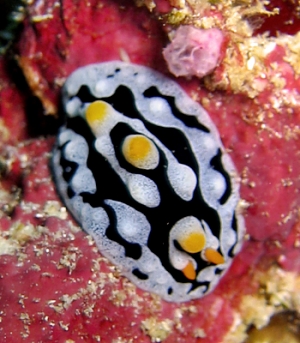
Concerning message #7255:
Hello Bill,
Can you please assist in identifying this nudi? I'm not quite sure if this is a Phyllidia coelestis or a juvenile Phyllidia varicosa.
Attached are two images, which one of them shows an egg ring next to the nudi. I've a feeling it's just coincident that this nudi is next to this ring of eggs. Don't thing the eggs belong to this nudi. But maybe you'll find it useful information.
Locality: Sipadan Island, Sabah, Malaysia, Celebes Sea. Depth: 18 metres. Length: 1.5 cm. March 13, 2004. Wall of Coral Reef. Photographer: Asther Lau
Regards,
Asther M. Lau
asther@astherlau.com
Lau, A, 2006 (Aug 8) Phyllidia coelestis? from Borneo. [Message in] Sea Slug Forum. Australian Museum, Sydney. Available from http://www.seaslugforum.net/find/15656
Dear Asther,
It is still not easy to distinguish some species of Phyllidia clearly, and this is especially true of juveniles. I would suspect this may be a juvenile of Phyllidia ocellata or perhaps Phyllidia exquisita but I'm afraid I can't be positive.
I can't say anything about the egg ribbon other than that it definitely was not produced by the small phyllidiid, and it certainly didn't hatch from the ribbon.
Best wishes,
Bill Rudman
Phyllidia exquisita from the Philippines
May 13, 2006
From: Frranca Wermuth
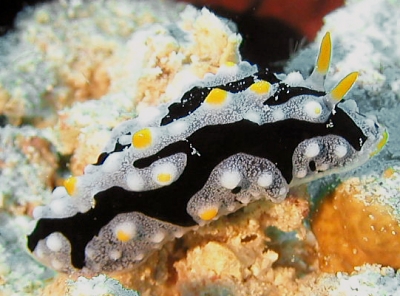
Dear Bill
Here is - I guess - a picture of Phyllidia exquisita?
Locality: Romblon Island, Romblon Province, Philippines, South China Sea, April 2003. Photographer: Franca Wermuth.
Thanks for your help
Franca
fmwermut@active.ch
Wermuth, F., 2006 (May 13) Phyllidia exquisita from the Philippines. [Message in] Sea Slug Forum. Australian Museum, Sydney. Available from http://www.seaslugforum.net/find/16489Dear Franca,
I am sometimes not convinced that some of these species such as P. exquisita, P. babai and P. willani are really distinct species or whether they are extremes of P. ocellata, but whatever is decided in the future, your animal is almost identical to Brunckhorst's photo of P. exquisita, even in only having yellow around the anterior end of the mantle edge.
Best wishes,
Bill Rudman
Phyllidia exquisita from Kerama Ids
October 18, 2000
From: Atsushi Ono
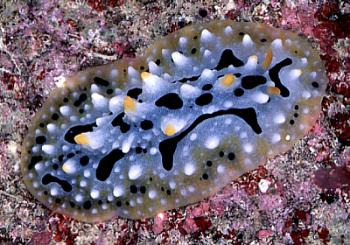
Dear Bill,
Thank you for a comment on haminoeid sp. and thank you, Clay & Patty Jo.
Now I have attached an animal that is a bit similar to Phyllidia willani, but I think it is P. babai because it has yellow edge to the mantle. Is my idea correct?
This animal is about 45mm long, found at 20m depth, at Kerama Is. near Okinawa in Japan.
Sincerely,
Atsushi Ono
ononini@cosmos.ne.jp
Ono , A., 2000 (Oct 18) Phyllidia exquisita from Kerama Ids. [Message in] Sea Slug Forum. Australian Museum, Sydney. Available from http://www.seaslugforum.net/find/3196Dear Atsushi,
The two species you mention and Phyllidia exquisita were all named by Brunckhorst (1993)in his comprehensive revision of the family. The relationsghip between these three species and Phyllidia ocellata will take a while to sort out because we still do not know the colour variability of each species. Your animal has features of all three species but I would suspect that it is Phyllidia exquisita. Brunckhorst considers the black line betwee the rhinophores and how it divides into two both posteriorly and anteriorly, to be quite significant.
I am not totally convinced they are all good species, but on colour pattern I would feel your photo is best considered to be of P. exquisita.
Best wishes,
Bill Rudman.
Phyllidia exquisita from the Maldives
June 8, 2000
From: Erwin Koehler
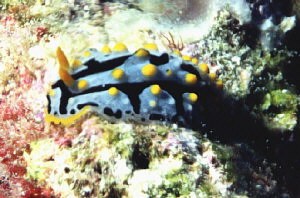
Dear Bill,
When taking this photo I thought this is a juvenile Phyllidia varicosa, but now I think it is Phyllidia exquisita, because of the yellow edge to the mantle margin. Possibly this is the first record from the Maldives.
Size 23 mm, depth 26 m, Oct. 25, 1999, North Male Atoll, Giraavaru Is., divesite "Kuda Haa".
Erwin.
Medslugs.Koehler@t-online.de
Koehler, E., 2000 (Jun 8) Phyllidia exquisita from the Maldives. [Message in] Sea Slug Forum. Australian Museum, Sydney. Available from http://www.seaslugforum.net/find/2519Dear Erwin,
Yes I think it is Phyllidia exquisita. I am not sure if it has been recorded from the western Indian Ocean before, but even if it has it is certainly an interesting record.
Best wishes,
Bill Rudman.
Phyllidia exquisita from NW Australia
May 9, 1999
From: Clay Bryce
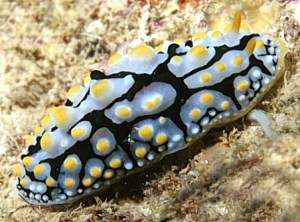
Dear Bill,
Here is another species, perhaps a new record?, from the Dampier Archipelago in the Kimberley region, Northwestern Australia.
WAM1461: Is this Phyllidia exquisita - note the yellow mantle margin on the
anterior end. This animal is consistent in colour from Shark Bay to the Montebellos Is and Dampier Archipelago. I haven't as yet checked my slides to see if it goes further north.
Clay Bryce,
W.A. Museum
Perth.
brycec@museum.wa.gov.au
Bryce, C., 1999 (May 9) Phyllidia exquisita from NW Australia. [Message in] Sea Slug Forum. Australian Museum, Sydney. Available from http://www.seaslugforum.net/find/838Dear Clay,
I think you are right. Brunckhorst notes that tubercles are black when they are on a black background and yellow capped on a white background. I suspect the bluish background in your animal suggests a slightly more mature animal. His photo shows a yellow border around the anterior end but his description describes the yellow border continuing right around the mantle edge. I guess the yellow border being confined to the anterior end in your animals and his photo (at Top of Page) may just be a coincidence and not necessarily a constant characteristic of the species.
I think Thailand is the only Indian Ocean record so NW Australia is quite a range extension.
Best wishes,
Bill Rudman.
